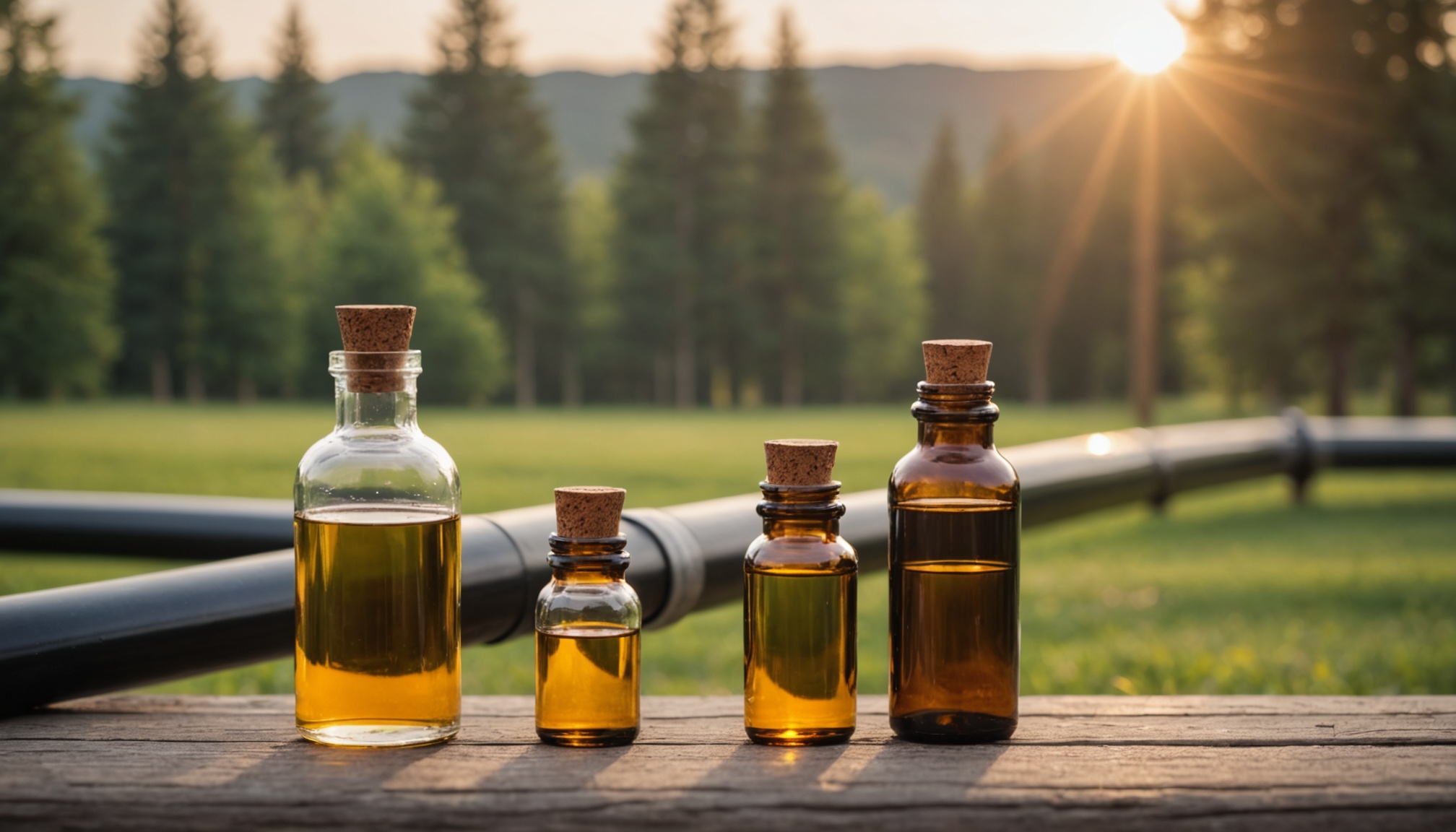Reliable transport and performance in the oil industry hinge on the selection of the right pipe solutions. Understanding the various materials—such as steel and PVC—as well as their applications and specifications is essential for efficiency. Whether for drilling or transportation, informed choices lead to enhanced durability and compliance with industry standards. Discovering optimal solutions ensures seamless operations and long-term success in oil projects.
Overview of Oil Pipe Solutions
When considering the best options to ensure the efficient and safe transport of oil, understanding the various oil pipe types and their specifications becomes essential. Whether you’re planning to purchase oil pipe for residential heating or large-scale industrial systems, selecting the right material and size is crucial for optimal performance and compliance with regulations.
Also to see : Optimize your workflow with maintenance management software cmms
Types of Oil Pipes and Their Applications
- Steel Pipes: Known for their durability and high-pressure tolerance, steel pipes are preferred for commercial installations or large-scale operations. However, they require proper coating to prevent corrosion.
- Plastic-Coated Copper Pipes: Lightweight and easy to install, this type is highly regarded for residential use. Its plastic coating adds an extra layer of protection against external damage and corrosion, especially ideal for underground installations.
- PVC Pipes: Typically used in low-pressure systems, PVC pipes offer a cost-effective solution but should be limited to specific applications due to limited temperature and pressure resistance.
Sizes and Specifications for Oil Pipes
Oil pipes come in a variety of sizes and specifications tailored to individual requirements. For residential systems, 10mm and 15mm pipes are common, accommodating the typical flow rates needed for household heating systems. Commercial projects might demand larger diameters to manage higher volumes efficiently and to meet strict safety standards.
Maintenance Tips for Oil Delivery Pipe Systems
Regular inspection and maintenance significantly extend the lifespan of an oil pipe system. Key practices include:
Also to see : Optimize your workflow with maintenance management software cmms
- Inspecting pipe joints: Leaks often originate from improperly sealed connections. Tightening or replacing fittings promptly is essential.
- Pressure Testing: Especially critical for underground pipes, periodic testing ensures there are no hidden leaks or weaknesses.
- Protective Measures: Applying insulation to exposed pipes provides a safeguard against freezing during low temperatures, improving system reliability.
By incorporating these practices, users can maintain efficient and safe operations while preventing costly repairs in the long run.
Installation Guidelines for Oil Pipes
Best Practices for Heating Oil Pipe Installation
When installing heating oil pipes, proper planning and material selection are vital. Begin with plastic-coated copper pipes, as they offer durability and flexibility, making them an excellent choice for residential systems. If using steel pipes, ensure they are coated to resist corrosion. Underground installations require pipes to be buried at a minimum depth of 450mm in a trench supported by compacted sand for protection against accidental damage. Additionally, external pipes should maintain a continuous incline, preventing air pockets that may obstruct oil flow.
Safety Measures for Oil Tank Fittings
Oil tank fittings installation demands strict adherence to safety protocols. Before starting, ensure the fittings are compatible with both the tank material and pipe type. Install a fire valve outside the building to cut off oil supply during emergencies. For buried systems, avoid placing pipes less than 300mm from other underground utilities to maintain safety. Where pipes pass through walls, enclose them in larger sleeves and anchor them securely.
Beginner’s Guide to Oil Pipe Installation Guidelines
Beginners should focus on selecting the right pipe for heating oil to ensure efficiency. Start with 10mm pipes, as they are common in residential systems. Minimise joints for simplicity and reduce the risk of leaks. Regularly inspect and maintain pipes for secure operation. Always consult an OFTEC-registered technician to confirm installation aligns with regulations.
Regulatory Standards for Underground Oil Pipes
Key Regulations Affecting Underground Oil Pipe Use
Underground oil pipe regulations emphasize the need for proper installation to guarantee safety, durability, and environmental compliance. Oil pipes must be justifiably sized to maintain efficient oil transfer and ensure compatibility with the system. Regulatory codes mandate that oil pipe fittings and compatibility meet specific standards to avoid leaks and other failures. For underground placement, trench depths should generally be 450mm, with a minimum of 300mm separation from other utilities.
Moreover, considerations for underground oil pipes include the use of materials like plastic-coated copper pipes or suitably treated steel, which resist corrosion effectively. Specific measures, such as compacted sand cushioning, are essential for added protection against accidental damage. For additional safety during inspections, pipe joints should be minimized and accessible.
Evaluating Environmental Factors in Installation
Environmental regulations for underground oil piping play a pivotal role, ensuring eco-friendly practices during installation. Proper materials and best practices for piping oil prevent environmental contamination caused by leaks. Installers typically avoid areas with soil prone to erosion or high groundwater risks. Labeling pipelines with high-visibility marking tapes is another requirement, serving as a critical visual warning.
Compliance with Safety Standards and Best Practices
Safety codes for underground installations often prescribe fire protection devices, like remote-activated fire valves, to mitigate fires. Routine maintenance and oil pipe insulation benefits provide additional layers of security. Pressure testing of buried pipelines is a non-negotiable practice, ensuring continued performance and safety of the systems.
Troubleshooting and Maintenance of Oil Pipes
Techniques for Identifying and Fixing Oil Leaks
Troubleshooting oil leaks in pipes begins with a systematic inspection of visible sections of the pipeline. Look for wet spots, stains, or pooling oil beneath the pipe. If the pipe is underground, changes in soil texture or vegetation growth above it can signal a leak. For confirmation, pressure testing is an effective method to detect compromised sections. Once a leak is identified, quick fixes like pipe clamps or epoxy sealants can provide temporary relief, but a professional evaluation is recommended for permanent repairs. Regularly inspect and test your oil delivery pipe systems, especially in older installations, to prevent costly emergencies.
Maintenance Tips for Long-lasting Oil Pipe Performance
Consistently maintaining pipes ensures their durability and efficiency. For above-ground pipes, applying protective coatings prevents corrosion. Oil pipe maintenance tips stress the importance of securely fastening pipes with proper supports, especially for installations in harsh weather conditions. Underground pipes should be insulated with protective layers, adhere to regulatory burial depths of at least 450mm, and be cushioned in compacted sand. Replacing worn-out oil pipe fittings and inspecting pipe joints can also mitigate potential issues.
Importance of Knowing Common Oil Pipe Sizes for Efficient Repair
Awareness of common oil pipe sizes, like the 10mm oil pipe often used in residential heating systems, ensures efficient repairs and replacements. Using pipes sized incorrectly can lead to airlocks or restrict oil flow, compromising system performance. Always reference specifications to select compatible materials and fittings.
Oil Pipe Material Considerations
Comparison of Plastic and Copper Oil Pipes
Plastic and copper oil pipes serve distinct purposes in heating oil systems. Copper pipes, particularly plastic-coated copper pipes, are widely recognised for their durability and resistance to corrosion, making them an ideal choice for external installations. Their flexibility simplifies the installation process, accommodating challenging configurations. In contrast, plastic pipes are commonly used for underground applications due to their affordability and resistance to environmental moisture. However, plastic pipes require additional protective casing to shield against external damage.
Benefits and Drawbacks of Various Materials
When assessing oil pipe materials, durability and corrosion resistance are critical factors. Copper pipes excel in both areas, withstanding high temperatures and offering long-term reliability. However, they come with higher upfront costs compared to plastic alternatives. Plastic pipes are lightweight and cost-effective, yet are prone to degrading under prolonged exposure to sunlight or high temperatures. Their use is generally more limited to below-ground setups with adequate protection against physical stress.
Choosing the Right Material Based on Application
Selecting the proper pipe material depends on the intended application. For above-ground installations, the advantages of using corrosion-resistant oil pipes, like copper, outweigh their cost. Underground systems benefit from plastic pipes due to their lightweight nature and affordability, provided installation follows strict guidelines to ensure safety and efficiency.
Innovations in Oil Pipe Technology
Latest Trends in Oil Pipe Manufacturing
Recent innovations in oil piping technology have reshaped the efficiency and durability of systems across sectors. One standout trend is the growing use of composite materials, combining plastic and metals to enhance corrosion resistance and flexibility. Additionally, processes like automated welding and 3D scanning ensure precision in pipe fabrication, significantly reducing manufacturing defects. These advancements are particularly beneficial in creating adaptable oil piping systems for varying industrial applications, maintaining performance under diverse conditions.
Metrics for Evaluating Pipe Performance
When assessing oil pipe performance metrics, several key factors come into play. Pressure ratings determine a pipe’s ability to transport fluids under specific conditions, while measurements of thermal expansion highlight the material’s tolerance to varying temperatures. Compatibility with heating oil and resistance to leakage or contamination are also critical. Such metrics play a vital role in selecting heating oil pipes for efficiency and ensuring long-term reliability for both underground and above-ground systems.
Adapting Oil Piping Solutions to Meet Diverse Industry Needs
Industries demand durable oil piping materials to withstand different environments. Underground pipes, for example, require protection against physical damage and corrosion. Innovations like plastic-coated copper pipes have proven effective, offering a balance of longevity and affordability. Furthermore, pipe designs now prioritize adaptable configurations for residential heating oil systems and commercial applications, simplifying installation and maintenance processes.
Selecting Suppliers and Accessories for Oil Piping Systems
Tips for Identifying Reliable Oil Pipe Suppliers
When pinpointing high-quality oil pipe suppliers, several aspects should come under scrutiny. First, assess the durability of the materials they offer. For essential oil piping systems, suppliers specializing in corrosion-resistant oil pipes—like plastic-coated copper or steel—tend to ensure longer-lasting solutions. Additionally, suppliers meeting compliance with underground oil pipe regulations likely prioritize safety and quality.
Check for guarantees on pipe dimensions, wall thickness, and compatibility with fittings. Trusted suppliers should provide critical specifications like pressure ratings, ensuring the pipes suit your intended use. Vendor reputation is also a marker—look for those recognized for consistency in delivering standard-compliant products.
Recommended Accessories to Enhance Oil Pipe Systems
Adding essential accessories for oil piping systems reflects on system efficiency. For better flow management, include high-precision oil valves and 10mm oil pipe fittings tailored for secure connections. Fire valves are non-negotiable for safety, halting oil flow during emergencies. Installing insulation for outdoor oil lines can also prevent environmental damage and optimize performance.
Locating Local Resources for Oil Pipe Fittings and Accessories
Where to find oil pipe fittings locally depends on your region but always engage certified retailers adhering to verified standards. Hardware stores or specialty plumbing outlets often stock various 10mm accessories. Confirm their inventory supports regulations for both surface and underground applications.









